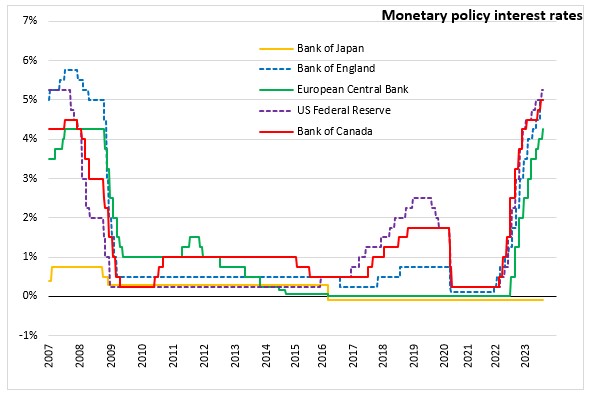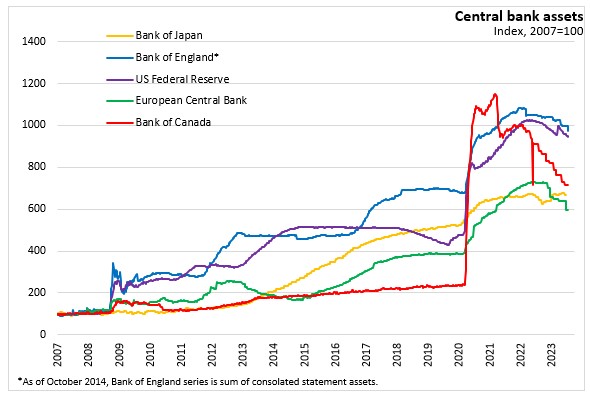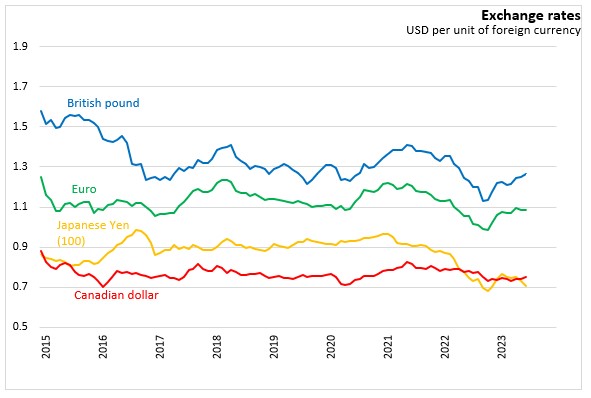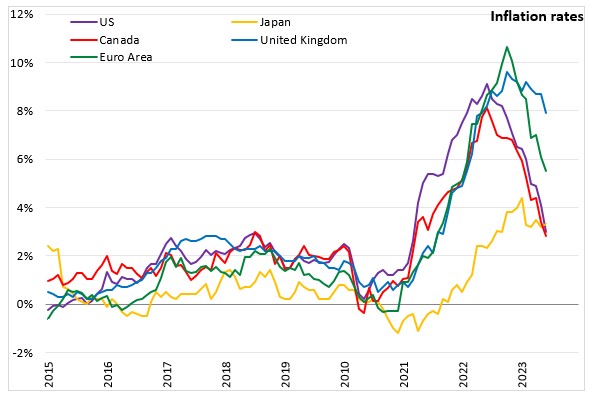The Economics and Statistics Division maintains archives of previous publications for accountability purposes, but makes no updates to keep these documents current with the latest data revisions from Statistics Canada. As a result, information in older documents may not be accurate. Please exercise caution when referring to older documents. For the latest information and historical data, please contact the individual listed to the right.
<--- Return to Archive
For additional information relating to this article, please contact:
July 28, 2023BANK OF JAPAN MONETARY POLICY The Policy Board of the Bank of Japan decided to maintain a negative interest rate of 0.1% for the Policy-Rate Balances in current accounts held by financial institutions at the Bank.
The Bank of Japan will also purchase a necessary amount of Japanese government bonds (JGBs) without setting an upper limit in order to keep the 10-year JGB yields at around zero per cent. The Bank will continue to allow 10-year JGB yields to fluctuate in the range of around plus and minus 0.5 percentage points from the target level, and will offer to purchase 10-year JGBs at 1.0 percent every business day through fixed-rate purchase operations, unless it is highly likely that no bids will be submitted.
In addition, the Bank will purchase exchange-traded funds (ETFs) and Japan real estate investment trusts (J-REITs) as necessary so that their amounts outstanding will increase at annual paces with upper limits of about 12 trillion yen and about 180 billion yen, respectively. The Bank will maintain Commercial Paper (CP) holdings at 2 trillion yen and will purchase corporate bonds at about the same pace as before the COVID-19 pandemic with amounts outstanding gradually returning to about 3 trillion yen.
The Bank will continue with “Quantitative and Qualitative Monetary Easing (QQE) with Yield Curve Control”, aiming to achieve the price stability target of 2 per cent, as long as it is necessary for maintaining that target in a stable manner. The Bank also noted that it will continue expanding the monetary base until the year-on-year rate of increase in the observed CPI (all items less fresh food) exceeds 2 per cent and stays above the target in a stable manner.
Japan's economic activity has recovered moderately. Exports and industrial production have remained flat as easing supply chain constraints were offset by slowing global demand. Corporate profits have been at high levels on the whole with business fixed investment increasing moderately.
The employment and income situation has seen moderate improvements despite some continued weakness in some sectors. Private consumption has also increased despite price rises. Housing investment has been relatively weak.
The year-on-year inflation in the consumer price index (CPI, all items less fresh food) increased by 3.3% in June 2023. This was up from 3.2% CPI recorded in May but down from 4.4% in January 2023. Due to the effects of the pass-through to of cost increases led by import prices, the year-on-year rate of change in the CPI (all items less fresh food) has been around 3.5% recently, slower than a while ago.
Japanese recovery has also been slowed by high commodity prices. As the negative impact of high commodity prices wanes and a virtuous cycle from income to spending intensifies gradually, Japan's economy is projected to continue growing at a pace above its potential growth rate.
As of its July Outlook for Economic Activity and Prices, the Bank expects real GDP to increase 1.3% in 2023, 1.2% in 2024 and 1.0% in 2025. These represent a downgrade for this year from the April 2023 Outlook. The Bank expects Japan's inflation to average 2.5% in 2023, 1.9% in 2024 and 1.6% in 2025. Inflation projections are revised up for 2023 but down for 2024 from the April 2023 Outlook.
The Bank of Japan noted that it will continue with monetary easing while nimbly responding to developments in economic activity and prices as well as financial conditions to achieve the price stability target of 2.0% in a sustainable and stable manner, accompanied by wage increases.
The next scheduled monetary policy meeting will be held on September 22, 2023.




Source: Bank of Japan, Statement on Monetary Policy (July 28, 2023), Outlook for Economic Activity and Prices (July 2023)
<--- Return to Archive